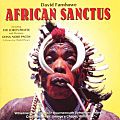African Sanctus facts for kids
African Sanctus is a special piece of music. It uses a choir, solo singers, an orchestra, and recorded sounds. David Fanshawe created it in 1972.
This is David Fanshawe's most famous work. He wrote it after traveling through Africa along the Nile River. He went on these trips between 1969 and 1973. His journey looked like a cross, which was important to him for religious reasons. While in Africa, he recorded many people singing their traditional songs. Many of these songs had never been recorded before! When he came back to Great Britain, he used these recordings to create African Sanctus. During a performance, you'll hear these original African sounds. The live choir sings parts of the traditional Christian Latin Mass.
The recorded sounds come from countries like Egypt, Sudan, Uganda, and Kenya.
At first, the music was called African Revelations. Later, its name was changed to African Sanctus. The first performance was in London in July 1972. The Saltarello Choir performed it. It was also played on BBC Radio on United Nations Day. Three years later, a film was made. It showed how David Fanshawe created this amazing music.
Contents
- What is African Sanctus About?
- Movement 1: Royal Welcome Dance
- Movement 2: Call to Prayer
- Movement 3: Egyptian Wedding
- Movement 4: Courtship and Praise
- Movement 5: Desert Song
- Movement 6: Song of Hope
- Movement 7: Frogs, Dance, and Storm
- Movement 8: Madinda and Holy Sounds
- Movement 9: The Lord's Prayer
- Movement 10: Milking and River Songs
- Movement 11: Thinking of Refugees
- Movement 12: A Different Kyrie
- Movement 13: Energetic Dance
- Where Has African Sanctus Been Performed?
- See Also
- Images for kids
What is African Sanctus About?
African Sanctus is divided into 13 parts, called movements. Each movement mixes live choir singing with recordings David Fanshawe made in Africa.
Movement 1: Royal Welcome Dance
- This part uses music from northern Uganda.
- The Acholi people perform a special royal welcome dance.
- The live choir sings the words of the Sanctus, which means "Holy."
Movement 2: Call to Prayer
- You'll hear a recording of the Azan. This is a call to prayer by an Imam in Cairo, Egypt.
- The live choir sings "Kyrie," which means "Lord, have mercy."
- Fanshawe brings together two different faiths: Islam and Christianity.
Movement 3: Egyptian Wedding
- This movement starts with music from an Egyptian wedding.
- The live choir sings the Gloria, often with lots of energy.
Movement 4: Courtship and Praise
- This part features courtship dances.
- It leads to four men singing from the Quran in different languages and Arabic.
- The live choir sings words of thanks and praise to God.
Movement 5: Desert Song
- You'll hear a cattle boy singing in the desert. This is near the Red Sea Hills.
- Bells ring to announce the birth of a baby boy.
Movement 6: Song of Hope
- A Zande family sings a song about Jesus.
- They had to leave their home in South Sudan and fled to Uganda.
- Their song is about being saved from the terrors of war.
Movement 7: Frogs, Dance, and Storm
- You'll hear the sounds of frogs.
- There's also a Ugandan dance where young girls praise their boyfriends who are fighting.
- A storm arrives, and its sounds mix with the choir singing "Crucify!"
Movement 8: Madinda and Holy Sounds
- Many different sounds are mixed together here.
- We hear the Madinda, a type of xylophone. It's made from canoe boards placed over banana trunks.
- The live choir sings "Sanctus!" ("Holy!").
Movement 9: The Lord's Prayer
- The live choir sings a beautiful version of the Lord's Prayer.
- The words in this part are in English, not Latin.
- Fanshawe got the idea from hearing a mother singing sadly for a dead fisherman in Uganda.
Movement 10: Milking and River Songs
- The live choir sings "For thine is the kingdom."
- Four different songs are heard on the recording:
Movement 11: Thinking of Refugees
- This movement makes us think about people who are refugees.
- These are people who have had to leave their homes, like in Sudan and Rwanda.
- You'll hear the sound of war drums in the distance.
- The live choir sings the Agnus Dei, which means "Lamb of God."
Movement 12: A Different Kyrie
- This part is a repeat of the "Kyrie" from Movement II.
- But this time, the live choir and the recorded sounds are mixed in new ways.
Movement 13: Energetic Dance
- This is a return of the "Sanctus" and "Gloria" parts.
- It features the energetic dance of the Bwala dancers from Uganda.
Where Has African Sanctus Been Performed?
African Sanctus has been performed in many places. It has been played all over Great Britain and around the world. David Fanshawe often attends these concerts himself.
In 1994, David Fanshawe added a new part to the music. It was for a new recording of the work. This part is called "Dona Nobis Pacem - A Hymn for World Peace." It completed the Agnus Dei section. Because of this new recording, the BBC asked Herbert Chappell to make a new TV show. Herbert Chappell had made the first film about the music in 1975. The new show was called African Sanctus Revisited.
See Also
- David Fanshawe's programme notes (printed in Summer Celebration, Milton Keynes City Church programme 12 July 2009).
Images for kids


